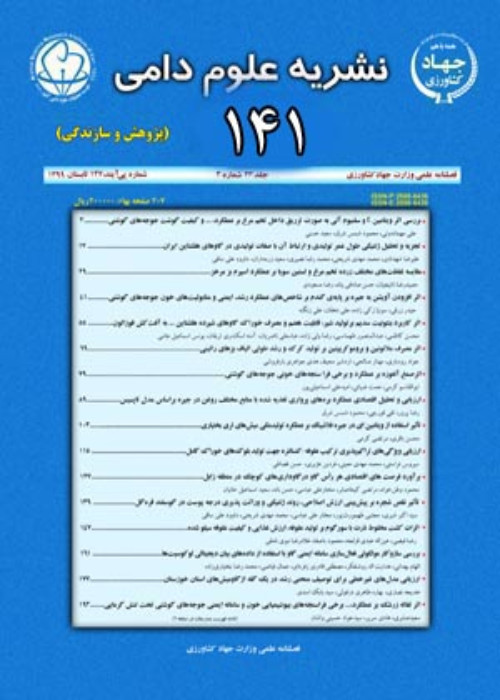Effects of fenugreek and fennel seeds on growth performance and reducing the population of gut micro flora in broiler chicks
Author(s):
Abstract:
Trigonella foenum-graecum (Fenugreek) and Foeniculum vulgare (Fennel)، in feed on growth performance traits including: Average daily feed intake (ADFI)، average daily gain (ADG) and feed conversion rate (FCR) and on antimicrobial activity of gut micro flora traits including: total number of bacteria in samples (TNB)، number of G- bacteria in samples (NGB)، number of Coli form bacteria in samples (NCFB) and recognition of Salmonella throughout the samples gathered from Ileum of chicks of different treatments. Trial containing 4 treatments (rations) and 3 replicates with 12 pens and 15 chickens per each pen (totally 180 chicks). Rations were balanced by NRC tables for different stages of growth from 1-21 and 21-42 days of old. The treatments were: 1. Control diet (without additives)، 2. Diet accompanied with 2 mentioned mixed powder plants (0. 5% of total diet)، 3. Diet with TF mixed powder plant and 4. Diet with FV mixed powder plant. All of additives through of diets were mixed to 0. 5% of total diet weights. According to the results the most ADFI (116. 19 and 116. 02gr/d) and ADG (53. 30 and 52. 98gr/d) related to treatment number 4 and 2 respectively. They were significantly different with other treatments (p<0. 05). Mentioned measures for treatments number 3 and 1 (control) were 103. 19، 112. 88 and 45. 26، 50. 39 gr/d respectively. FCR for treatment number 4، 2، 3 and 1 were 2. 19، 2. 18 2. 28 and 2. 24 respectively. The treatment group of 4 and 2 had a significant different with 3 or 1 (p<0. 05). Also culturing analysis of gut micro flora samples shown that the lowest total count of bacteria (TNB) belonged to number 2 and then 3 treatments with measure of 8. 83 for both of them (on basis of log10). The highest count belonged to control and then to number 4 treatments with counting of 10. 00 and 9. 50 respectively. The differences between two groups were significant (p<0. 05). By the same way، this algorithm repeated for counting of G- and Coli form bacteria، so the treatments 3 and 2 had the lowest (7. 33 and 7. 83 for G-، 6. 00 and 6. 50 for Coli form)، and the treatments 1 and 4 had the highest (both 9. 33 for G-، 9. 00 and 7. 17 for Coli form) counting of bacteria through the samples. The differences between this two groups for 2 type of bacteria were significant (p<0. 05). Results of culturing and isolating Salmonella for all the samples were negative.
Language:
Persian
Published:
Animal Sciences Journal, Volume:23 Issue: 88, 2011
Pages:
43 to 48
magiran.com/p928810
دانلود و مطالعه متن این مقاله با یکی از روشهای زیر امکان پذیر است:
اشتراک شخصی
با عضویت و پرداخت آنلاین حق اشتراک یکساله به مبلغ 1,390,000ريال میتوانید 70 عنوان مطلب دانلود کنید!
اشتراک سازمانی
به کتابخانه دانشگاه یا محل کار خود پیشنهاد کنید تا اشتراک سازمانی این پایگاه را برای دسترسی نامحدود همه کاربران به متن مطالب تهیه نمایند!
توجه!
- حق عضویت دریافتی صرف حمایت از نشریات عضو و نگهداری، تکمیل و توسعه مگیران میشود.
- پرداخت حق اشتراک و دانلود مقالات اجازه بازنشر آن در سایر رسانههای چاپی و دیجیتال را به کاربر نمیدهد.
دسترسی سراسری کاربران دانشگاه پیام نور!
اعضای هیئت علمی و دانشجویان دانشگاه پیام نور در سراسر کشور، در صورت ثبت نام با ایمیل دانشگاهی، تا پایان فروردین ماه 1403 به مقالات سایت دسترسی خواهند داشت!
In order to view content subscription is required
Personal subscription
Subscribe magiran.com for 70 € euros via PayPal and download 70 articles during a year.
Organization subscription
Please contact us to subscribe your university or library for unlimited access!



